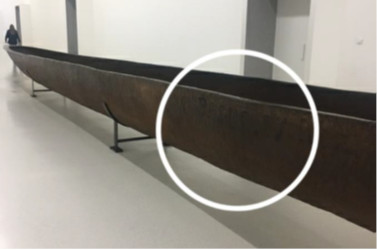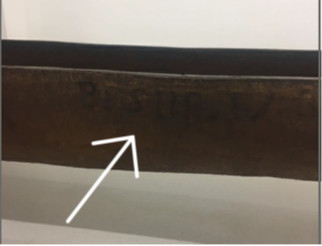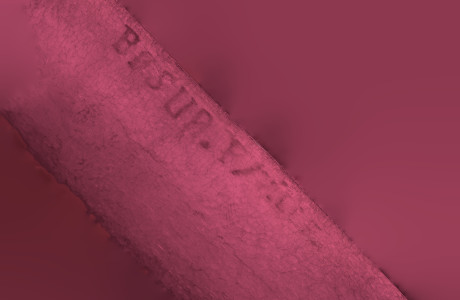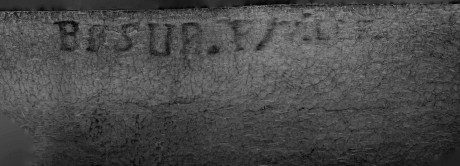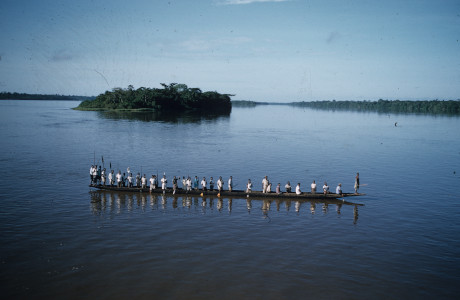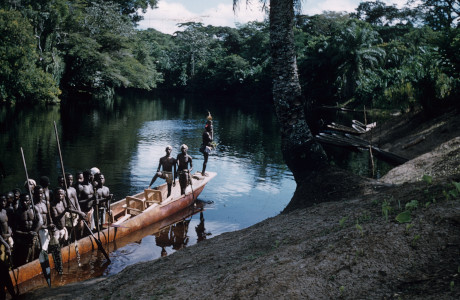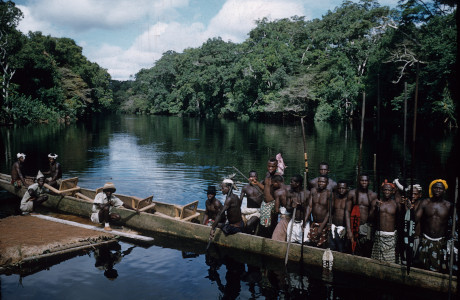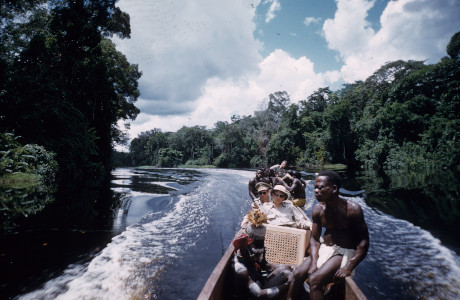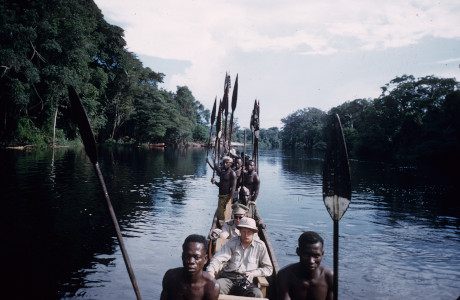The long dugout canoe
14.09.2021 (updated on 09.12.2025)
- EO.1958.1.1
- Donation from the territorial administration of Ponthierville (now Ubundu)
- Registered at the museum in 1958 (inv. EO.1958.1.1) as a gift from the Ponthierville territorial administration
- Wood identified by L. Bracq on 18/4/1958: Entandrophragma cylindricum Sprag
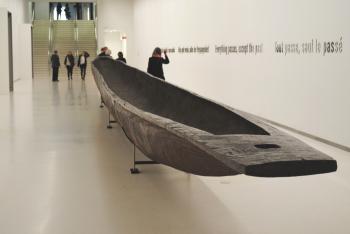
The museum's longest dugout canoe
The museum has more than twenty dugout canoes which are rarely exhibited or loaned because of their large size and the difficulty of moving them.
The most well-known is also the longest at +/-22 m and the only one to have been permanently exhibited since its acquisition in 1958.
The museum's director at the time, Frans-M. Olbrechts, stated that for many years he had wanted a monumental dugout canoe from the Wagenia region (DR Congo) to display in one of the museum's main galleries.
For the 1958 Brussels World's Fair, Olbrechts planned the creation of a spectacular museum piece for the public: he proposed to install the dugout canoe, filled with 80 stylised mannequins holding paddles, in one of the two main marble galleries.
This proposed display was clearly inspired by Gérard De Boe's film Pêcheurs Wagenia (1952), a colonial film about Wagenia fishermen that aimed to promote tourism in what was then known as the Belgian Congo.
Leopold III's journey in 1957
This photograph was taken near the village of Biondo (to the west of Ponthierville / (NKA Ubundu) in front of one of the two dugout canoes that were used to transport Leopold III during his short visit to the region. Leopold III is standing near the riverbank holding his camera, while the Territorial Administrator for Ponthierville, Mr Dereine, dressed in uniform, has his back to the camera. Carlo Van Elsen, Biondo, 29 March 1957. 2019.4.1
Photograph of one of the two boats with Princess Liliane Baels, Governor-General Pétillon, his aide-de-camp, Commandant Loos, and Viscount Gatien du Parc, among others. Carlo Van Elsen, Ruiki River (Biondo), 29 March 1957. 2019.4.2
It was Leopold III's much-photographed visit to the Congo in 1957 that would ultimately provide Olbrechts with the opportunity he needed for his project.
During the Leopold III's stay in Ponthierville (now Ubundu) at the end of March 1957, a two-day excursion was planned for him, travelling up the Ruiki River from the village of Biondo. Everything was prepared for this little expedition and two long dugout canoes awaited Leopold III and his entourage in Biondo.
According to Carlo Van Elsen, Assistant Territorial Administrator for Ponthierville, these two dugouts were made in the village of Bamanga, belonging to the Baleka chiefdom (related to the Lengola populations), 20 km to the north of Ponthierville towards Stanleyville (now Kisangani). Much like the Wagenia in Stanleyville, the inhabitants of Bamanga lived by trap fishing among the river's little waterfalls.
In a typed note, Van Elsen also describes the general background to the construction and use of this type of long dugout. They were made by the community under the supervision of two specialists, called moeli. Once finished, they were given to the village chief who could use them as he saw fit. He entrusted the dugouts to a guard, the nkota (who also acted as messengers during conflicts). When a family from the community wished to use the dugout for transport, permission had to be obtained.
Despite mentioning the village chief's crucial role in allowing the use of such a dugout, Van Elsen provides no information documenting the discussions or transactions that may have taken place with the Congolese for the provision of the dugout for Leopold III's use.
Olbrecht's requests for visual material
A few months after the Leopold III's visit, negotiations began between Olbrechts and the members of the territorial administration in Ponthierville to arrange for the dugout to be brought to Belgium.
Olbrechts, the museum's director, was personally involved in this acquisition, which he was very keen to display as a flagship of the institution.
It appears that he made initial contact with André Carpiaux, Assistant District Commissioner, who played a decisive role. But it was then Carlo Van Elsen, the Assistant Territorial Administrator, who effectively carried out the acquisition.
In order to prepare the future space in the museum's galleries, Olbrechts also contacted Police Commissioner Désiré Godchoul to obtain the dimensions and, more especially, to request a series of photographs to document the dugout's proportions.
In October 1957, while in hospital, Olbrechts also commissioned Belgian painter De Vaucleroy to produce a sketch of rowers whose outlines would be used as templates for their representation with metal tubes.
Gravelly ill, Olbrechts died in March 1958 and this planned display was abandoned.
The arrival of the dugout
The dugout arrived at the museum in January 1958. According to a "Note on the transport and installation of the Lengola dugout" by curator Albert Maesen, it was "offered to the museum by Mr C. Van Elsen." The press review of the coverage of this spectacular acquisition shows that articles at the time referred instead to a donation from the "territorial administration of Ponthierville." But the piece was recorded in the collections as a "donation from Carlo Van Elsen".
A photographic record of 14 images by the museum's photographer, F. Dubus, documents the arrival and installation of the dugout in the public galleries. The images show operations involving heavy machinery by the Belgian engineer corps stationed at Burcht, as well as the actual installation of the display by staff members.
Missing information
Olbrecht's death in March 1958 no doubt explains the lack of information relating to the dugout and its acquisition.
After visiting the museum in 1997, Van Elsen personally sent a letter to the museum correcting a number of erroneous details in the exhibition texts about the dugout, and clarified the status of the acquisition in two statements:
"De prauw was één van de 2 prauwen die aangekocht werden door de Inlandse Gemeenschappen van het gewest om te dienen voor de tweedaagse rondreis van Koning Leopold III en Prinses Liliane in een gedeelte van het gewest Ponthierstad."
"The dugout is one of two dugouts bought by the indigenous communities of the District to be used during the two-day visit to part of the Ponthierville region by King Leopold III and Princess Liliane."
"De prauw werd door de Inlandse Gemeenschappen van het Gewest geschonken aan het museum op verzoek van hulpdistrictcommissaris Carpiaux."
"The dugout was offered by the region's indigenous communities to the museum at the request of Assistant District Commissioner Carpiaux."
The dugout was therefore "offered at the request of Carpiaux". Given that Carpiaux personally answered the pressing request from the museum's director, it is likely that the Congolese in Ponthierville had little room for negotiation in this "request" from their administrative authority.
As is often the case, the agenda of the Congolese populations is missing from the story, especially as Carpiaux, who no doubt acted as the primary intermediary with them, left no direct evidence in the archives. In fact, he left the Ponthierville administration for Stanleyville at precisely this period, and handed over follow-up of the affair and correspondence with Olbrechts to his remaining colleagues, Van Elsen and Godchoul.
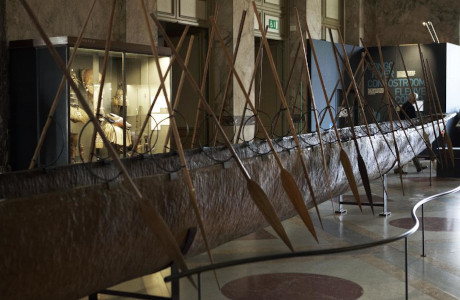
Olbrechts was also demanding in the scope of his material demands and in a relatively short time (letter dated 30 July 1957 to Van Elsen):
"Je ne sais pas si M. Carpiaux vous a fait part de notre vif désir de posséder, en même temps que la pirogue, le nombre de pagaies nécessaires à son équipage.
[…]
Je comprends qu’il ne pourrait pas être facile pour vous de réunir ce nombre de pagaies ; s’il n’est pas possible de nous en trouver 80, veuillez bien nous envoyer ce que vous trouvez. A moins que vous fassiez sur place, à nos frais, fabriquer les exemplaires manquants. Il va sans dire que notre Musée est tout disposé à payer tous les frais que l’exécution du projet ‘pirogue’ pourrait vous occasionner."
"I do not know if Mr Carpiaux has informed you of our keen desire to have, at the same time as the dugout, the number of paddles needed for its crew.
[…]
I understand that it may not be easy for you to gather this number of paddles; if it is not possible to find 80, please send us what you can. Unless you have the missing examples made on site, at our expense. It goes without saying that our Museum is prepared to pay all costs you may incur in delivering the 'dugout' project."
For the Assistant Territorial Administrator who had to maintain "good" relations with his citizens, it was obviously the second option that was chosen. The archives also show that the 80 paddles ordered by Olbrechts to accompany the dugout, produced specifically at the request of the correspondent Van Elsen, were bought for 40 francs each and were reimbursed by the museum.
But what currency was used for the dugout itself? It was an asset of particular importance (especially as the large trees used to make it became scarce after the 1960s).
Going back to basics: the pitfall of sources
Although, according to Van Elsen, the canoe was made in the village of Bamanga, lettering still visible on one of its sides indicates BASUA.P/VILLE. Basua is a village located along the Lualaba River, 20 km south of Ponthierville. This is probably the marking of the boat's home port, as required by the colonial administration. Each canoe had a specific nickname depending on its village. According to Van Elsen, in Basua, large canoes of this type were nicknamed Obaletomoi, which means 'the warriors show that we are strong'. This may therefore have been the name of this canoe. However, feedback from linguists at the University of Kisangani and their informants in the area has called into question a number of translations of the vernacular terms recorded in the archives concerning the canoe.
For example, in this case, the head of works, Nicolas MOMBAYA Liwila, learned that among the Basúwa: LOBALE TOMOI, composed of lobale "abdomen" + tómoí "one", refers to a fish with a single abdominal fin that moves very quickly, to differentiate it from other fish with a pair of abdominal fins (implying other canoes) that move slowly.
Other field research has yielded data that differs from that found in the archives. In 2023, the Bantu Rivers project team investigated the area around Biondo where Leopold III had travelled. In Babindja in particular, people remember his visit and the overnight camp at the foot of a "baobab tree" (which Leopold III mentions in his notebooks: "a magnificent tree at the end of the village" - 2004, p. 299), which has now disappeared from the old site. Informants descended from the inhabitants of Babindja report that the pirogue was built not far upstream on the Ruiki (Mr Ugombo is said to have been the leader of the team responsible for its construction).
In the absence of a thorough investigation, it is difficult to know whether it was built in Bamanga or Babindja. But these versions are not necessarily mutually exclusive; after all, there were two almost identical canoes that were used in the same context.
Colour photographs taken by Leopold III during his visit to the Congo in 1957:
Text compiled from a draft by Agnès Lacaille based on specific research and a synthesis of the data below.
SOURCES
Interviews and correspondence: Maarten Couttenier, Lutgard Doutrelepont, Siska Genbrugge, Han de Koeijer, Peter Lambertz (ULB), Jacky Maniacky, Nicolas Mombaya (Université de Kisangani), Emmanuel Ngbanga (Université de Kisangani), Jackie Van Goethem, Patricia Van Schuylenbergh, Anne Welschen.
The BANTURIVERS team:
Alexandre Livingstone Smith, RMCA; Laurent Nieblas-Ramirez, ULB; Nicolas Nikis, ULB, RMCA; David Kopa wa Kopa, ULB, Université de Kisangani; Wilson Mayo Ilodiri, Université de Kisangani; Michel Komba Yendema, Université de Kisangani; Clément Mambu Nsangathi, Institut des Musées Nationaux du Congo (IMNC); Olivier Mulumbwa Luna, Université de Lubumbashi, Sabrina Nkulu Kalwanika, Université de Lubumbashi; Jean-Paulin Ndjondjo Manga, Université de Kinshasa, IMNC.
Archives
- RMCA: Acquisition records from the Ethnography section (C. Van Elsen) and Administration (AA.2-D.2.1958.5 & AA.2-D.2.1957.2: Territorial Administrator of Ponthierville); Léopold III photographic archives
- National Archives of Belgium:
- Colony collection: personal records for Georges Dereine (33854), C. Van Elsen (38663), Carpiaux (36300) & Godchoul (34335)
- Metropole collection: personal records for Van Elsen C. (96540) , Carpiaux A. (93556) & Godchoul D. (25795)
- Fondation Léopold III, RBINS: original black and white photographs from Leopold III; colour slides; Deschepper – Van Goetham correspondence
Videos
Bibliography
- Exhibition catalogue for Fleuve Congo, 2010
- Deschepper Jacques, Congo 1957. Un voyage du roi Léopold III, 2012
- Léopold III, Carnets de voyages. 1919-1983, Brussels, Racines éd. / Fonds Léopold III, 2004, p. 299.
The information contained in this article is mostly based on resources available at the museum (archives, publications, etc.). The object's biography can therefore still be developed further. Do you have any comments, information or stories to share about this object or this type of object? Please contact us: agnes.lacaille@africamuseum.be.
In the framework of the Taking Care project.
